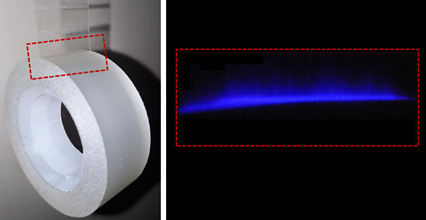“The fractoluminescence phenomenon, that is, the emission of visible light when a material breaks, is generally unknown from the general public. It is yet rather easy to observe it, as one may only need to quickly unroll some adhesive tape in the dark (as shown in the picture). This intriguing phenomenon can be explained by the extreme temperature – thousands of degrees – potentially reached very locally by the glue, at the place where it detaches from the roll. An adhesive that brutally fails could thus be hotter than the surface of our sun!
More than an amusing anecdote, such a process helps to better understand the brittleness of matter. Is not a potential menace for any of our everyday objects (from the screen of our phones to the arches of our bridges) the sudden growth of a fracture? This threat also lies on the very rocks on which we live, in which fractures sometimes generate dreadful earthquakes.
By studying the dynamics of the peeling of tape, but also that of the rupture of acrylic glass (PMMA), we show that sudden fractures can arise from an intense thermal dissipation. We predict that the quicker a crack is, the hotter it becomes. And, reciprocally, a warming crack accelerates. Indeed, the molecular agitation (whose intensity is related to the temperature) allows the rupture of the atomic bonds which keep solid matter together. This phenomenon could thus quickly amplify; a fracture can then suddenly reach thousands of degrees, and thus propagate dramatically.
A standard adhesive tape (to the left) quickly unrolled in the dark (image on the right). The dashed rectangles highlight the same area in both pictures. The blue light could arise from an adhesive temperature reaching about 7000°C.”
Tom VINCENT-DOSPITAL
Read the last publication in Soft Matter from Tom Vincent-Dospital, Renaud Toussaint, Stéphane Santucci, Loïc Vanel, Daniel Bonamy, Lamine Hattali, Alain Cochard, Eirik G. Flekkøy and Knut Jørgen Måløy on “How heat controls fracture: the thermodynamics of creeping and avalanching cracks” here:
Picture: A standard adhesive tape (to the left) quickly unrolled in the dark (image on the right). The dashed rectangles highlight the same area in both pictures. The blue light could arise from an adhesive temperature reaching about 7000°C.

